 |
| Austrian brigade of General Beck marches through the woods. |
I fought the Battle of Reichenberg from the 1762 campaign around Schweidnitz today. For convience, please click on this link
Here to my blog thread that describes the historical background and purpose of the battle of Reichenbach.
I played the battle as a solo game, but it should really be played with three players on each side. The scenario is largely focused on the action between the Austrian flanking column of Beck versus the Prussian army of Bevern. The game reached a definite conclusion in eight turns.
Please click on each picture to enlarge the view. You can even double click each picture for an even larger view.
 |
| Map illustrating the 3 attack columns of Beck’s corps. |
One feature of the scenario is the existence of a mixed force of Austrian dragoons (2 squadrons) and infantry (two battalions) that are positioned at Ober-Peilau in the map above. This force never attacked, but they caught the attention of the Prussians, who couldn’t simply move all of their infantry to counter Beck’s flanking movement. The Prussians, of course, do not know that these are „dummy troops“, but undoubtedly they will figure it out during the course of the game.
I also placed two Austrian batteries of artillery off table and had them firing at long range at the Prussian forces deployed on the Fischer-Berg and Spittel-Berg. The Austrians needed a die roll of „1“ on a D10 since the Prussians were in prepared earthworks. The Prussian artillery could hit the Austrian artillery on a die roll of „2“ on a D10, since the Austrian artillery was deployed in the open.
 |
| Austrian brigades of St. Ignon (cavalry) and Simbschen (infantry) demonstrate in front of the Prussian line. They are a decoy and never engage in the battle. |
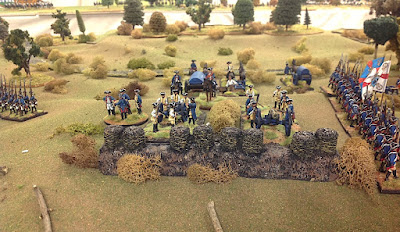 |
| Prussian redoubt atop the Fischer-Berg.
The Fight for the Girls-Berg
The second (middle) of Beck’s three columns was a mixed force of Grenadiers, Croats and a small 3-pound cannon, given the task of capturing the high ground known as the Girls-Berg. This feature had a commanding view of the Prussian deployment on the Fischer-Berg and the Spittle-Berg and a cannon atop the summit would have enfilading fire on the Prussian defenses.
Bevern had posted a single battalion of the von Diericke Fusilier Regiment (IR49/1) on the Girls-Berg, figuring that one battalion would be sufficient to defend this difficult ground. The second battalion of the regiment was posted between the Girls-Berg and the Fischer-Berg and it could easily march to support its sister battalion if any trouble brewed.
The Austrian Grenadier battalion was on the left and the Croat Ottocaner battalion was on the right. The 3-pounder was posted on the left flank of the Grenadiers. The assault commenced immediately on Turn One. Meanwhile, Beck would march the remainder of his column through the woods that was behind the Prussians (they had to wait until Turn Four before they could be placed on the table.
|
 |
| Turn Four: A desperate struggle to control the key Girls-Berg position. |
The lone Prussian fusilier battalion held its own against twice its number. The two sides commenced firing at one another on Turn Two, when the Grenadiers inflicted four hits on the Fusiliers, who passed their morale test. The Prussian fusiliers fired back and their volley caused the Croats to go Shaken, forcing them to fall back half a move.
The Prussian fusiliers took three more hits on Turn Three and managed to pass their morale test yet again. Meanwhile, the second battalion of fusiliers was marching as fast as they could to help their commrades defend the Girls-Berg.
 |
| Action on the Girls-Berg |
Both sides traded musket fire over the next three turns, taking terrible casualties, but neither side faltered. Finally, on Turn Seven, the first battalion of the fusiliers decided that it was time to settle the issue with the bayonet, so they charged the unformed Croats and routed them off the Girls-Berg. While this was going on, the fresh second battalion was cutting up the Austrian Grenadiers, who still managed to hold the summit of the hill.
Beck’s Austrian Column Attacks the Prussian Rear.
I measured the distance from the table edge to the point where the Austrian march through the woods would bring them to the point where they could roll out of the woods and attack the Prussian rear. Since infantry moves at half speed through the woods, it would have taken about 10 turns for Beck’s contingent to arrive in position. So I arbitrarily decided that they could arrive on the table on Turn Four. However, the Austrian regulars (3 battalions) would be required to emerge from the woods in a column of march, before they could deploy into line formation. The unformed Croats (2 battalions) could do what they pretty darn well pleased whilst in the woods – afterall, they are light troops.
 |
| On Turn 4, Beck’s corps finally emerges from the woods after a difficult march around the rear of the Prussian deployment. |
The overhead view of the battle on Turn Four is shown in the picture below. You can see that one Prussian musketeer battalion, in line formation, is moving towards the threat while a column of grenadiers closes in on the Austrians.
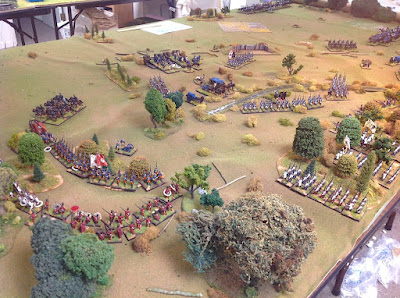 |
| An overhead view of the battlefield at the time that Beck arrives. Two Prussian battalions can be seen marching towards the woods to confront Beck’s attack. |
Beck’s troops sortied out of the woods on Turn Four, and did so before any Prussian infantry could contest the move, thus the Austrian regulars were able to form a battle line without paying the price for being fired at whilst in column formation. The fighting in this area was in a low lying marshy area called the Schober-Grund.
The following overhead view of the battlefield defines the geographical features of the terrain. Please click or double click the picture to enlarge the view.
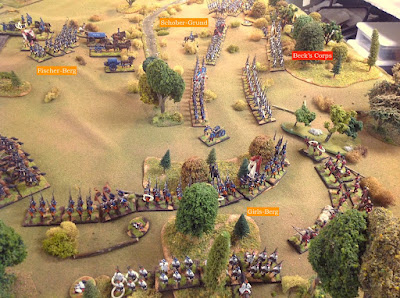 |
| Overhead view of the battle field from the Girls-Berg fight at the bottom and heading through the Schober-Grund at the top, as Beck’s corps emerges from the woods to attack the Prussian rear. |
On or around Turn Six, the Prussian commander realized that his infantry had a decided advantage over the Croats if they should happen to cross bayonets in a melee. Formed versus unformed troops in melee gives the formed unit a major advantage (i.e. they need 9’s or less on a D10) while the unformed unit is at a major disadvantage (needing a 2 or less on a D10). In other words, the formed unit is virtually an automatic winner of the melee. Indeed, the Croats got too close to some Prussian grenadiers, who promptly charged them and slaughtered them in the melee. The Croats had the good fortune of failing their morale test so that they could run away from the Prussians.
 |
| The Croats are about to find themselves on the business end of quite a few Prussian bayonets. |
Thus one battalion of the Kremzow Grenadiers (17/22) charged some brown-coated Croats from the front while the Wedell Grenadiers (1/23) hit them in the flank, which vaporized the unfortunate Croats. The Kremzow Grenadiers then engaged one of the Hungarian Nikolas Esterhazy battalions in a firefight.
While that was going on, the Wedell Grenadiers continued to advance through the woods in a two stand wide attack column (I only allow this formation for grenadiers in my rules) and tumbled into a battalion of blue-coated Croats. The outcome repeated itself and the Croats scampered away from the battlefield. The Wedell Grenadiers now found themselves behind the Austrian battle line! So on Turn Eight they turned facing, reformed and charged into the rear of the Nikolas Esterhazy battalion, which they destoyed.
 |
| The charge of the Wedell Grenadiers into the rear of the Nikolas Esterhazy battalion. This effectively decided the game for the Prussians. |
At this point, General Beck could see that any further fighting was pointless, as he was down to two battalions of regulars facing off against twice his number in the Schober-Grund. On the Girls-Berg, his grenadier battalion was still fighting it out with the two battalions of the von Diericke fusiliers. Beck tipped his tricorn to the Prussian commander and retired from the field. It was a Prussian victory that played out closely to the historical action.
 |
| Battle lines are drawn in the marshy Schober-Grund, prior to the destruction of the Esterhazy battalion, shown in the lower left side of the above picture. |
Special mention and battle honours should go out to the Wedell Grenadiers for their three melee victories, the von Diericke fusiliers for holding onto the Girls-Berg, and the Bayreuth Dragoons, who carved their way through the Austrian cavalry (see cavalry melee section below).
Brentano’s and Lacy’s corps never arrive at the front of the Prussian line, as they were supposed to do, leaving Beck hanging out to dry in the Schober-Grund. For this reason, I did not use any infantry troops to represent the other two Austrian corps.
Historically, Brentano and Lacy didn’t attack because they feared that their left flanks would be over run by Prussian cavalry. The great cavalry melee between O’Donnell’s Austrian cuirassiers and Lentulus‘ Prussian dragoons was played out as a separate scenario for the overall battle of Reichenbach (see story line below).
The Cavalry Battle
I am not going to go into the details of the large cavalry melee that occured on the Prussian right flank (Austrian left flank), but will let the picture captions tell the story. The Austrian cavalry, commended by O’Donnell, had 6 squadrons of cuirassiers. The Prussian cavalry of Lentulus had 6 squadrons of heavy dragoons and 1 squadron of hussars. So the two sides were relatively even, although the Austrians had better melee cavalry since they all were cuirassiers.
 |
| Prussian cavalry doctrine calls for cuirassiers in the first line, dragoons in the second line, and light hussars in the third line. |
The Prussian cavalry quickly gained the upper hand as the two sides thundered closer and closer to each other across the flat farm fields. As they both neared charging distance, the Prussians drew the first movement initiative and their charge caught the Austrians at the halt, giving the Prussians an advantage in the first round of the melee.
Since cavalry do nothing but melee, this part of the battle was over at the end of Turn Four. The Austrians lost 38 figures compared to only 18 lost for the Prussians. Despite the first round advantage for the Prussians, it was poor Austrian dice rolling that did them in.
In my rules, melees only last three rounds, at which point both surviving (i.e. not routing or shaken) sides will retire a full move back towards their own lines to reform.
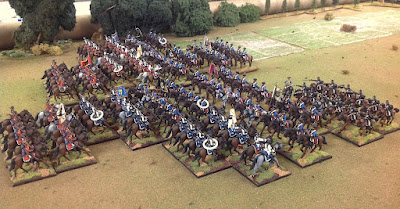 |
| The grand cavalry melee on the right flank of the Prussian battle line. |
The Prussian dragoons gave the Austrians a good thrashing, as you can see in the disparity of remaining figures in the picture below. Since this was a solo game, I didn’t see the need to keep fighting the cavalry melee as the Austrians would likely have been wiped out in another three rounds of melee.
Historically, the Austrian cavalry was giving the Prussian cavalry a hard time, until King Frederick arrived at the head of a large contingent of cuirassiers, hussars and Bosniak lancers, which tipped the scales in the Prussians‘ favor.
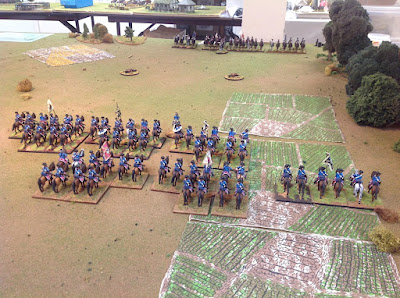 |
| The Prussians decisively win the cavalry melee and then both sides retire back to their lines as melees only last three turns in my rules. |
The end (or is it?).









